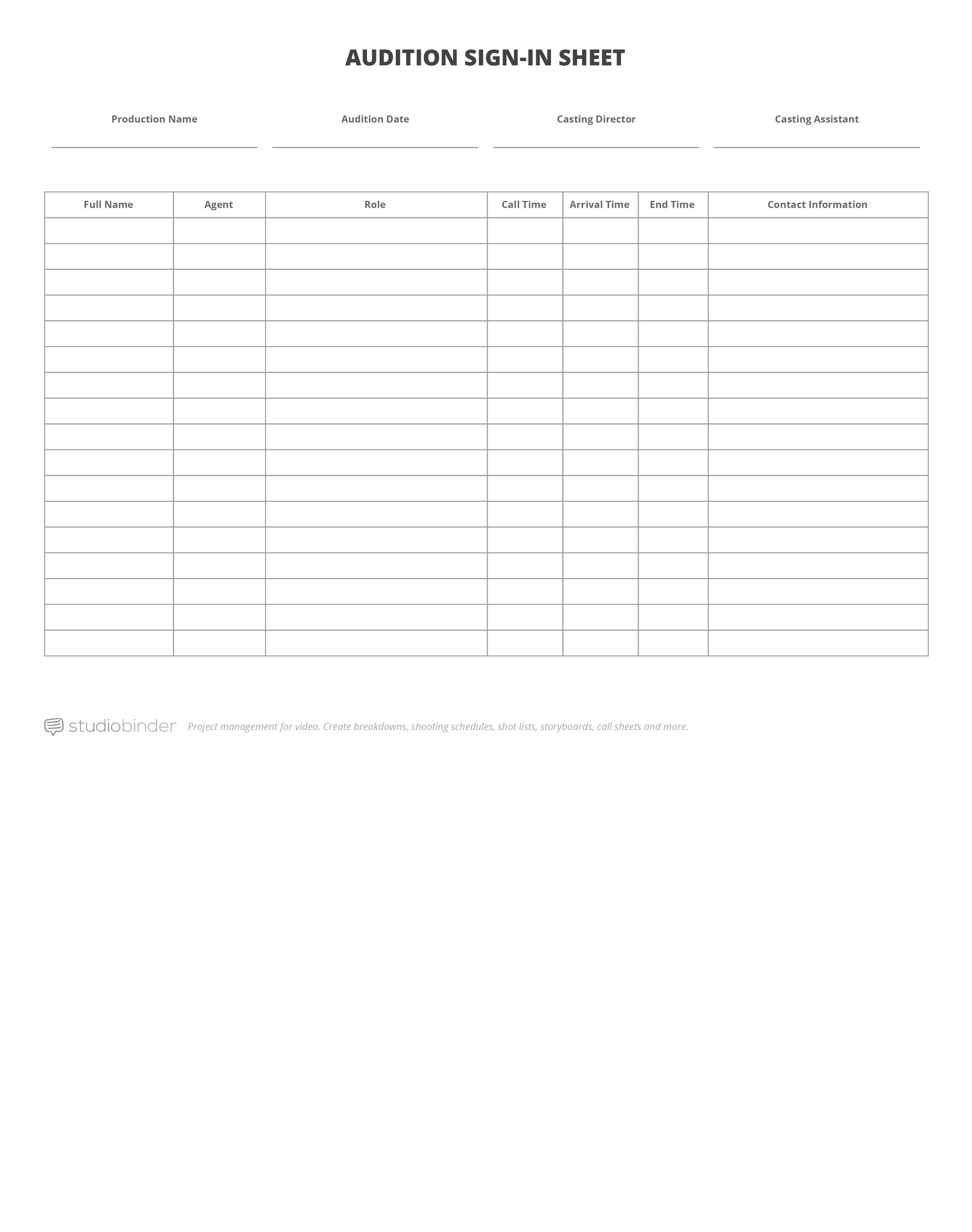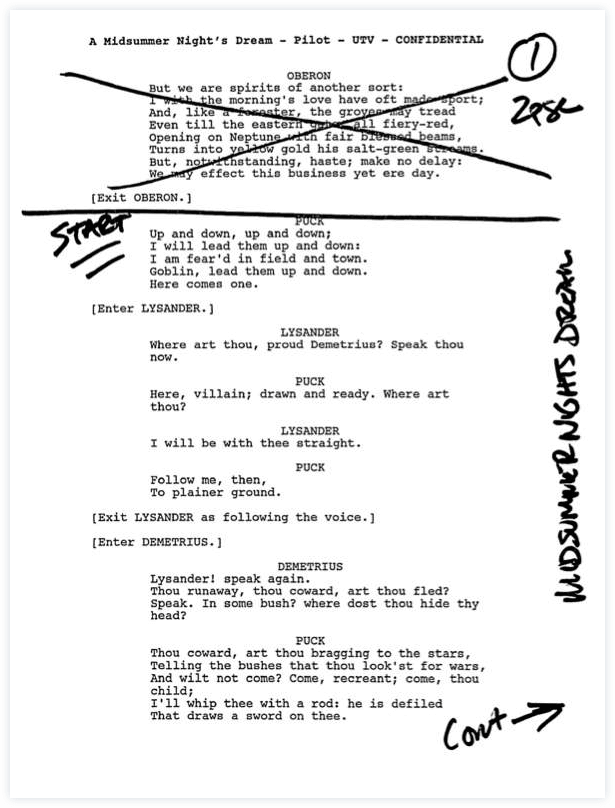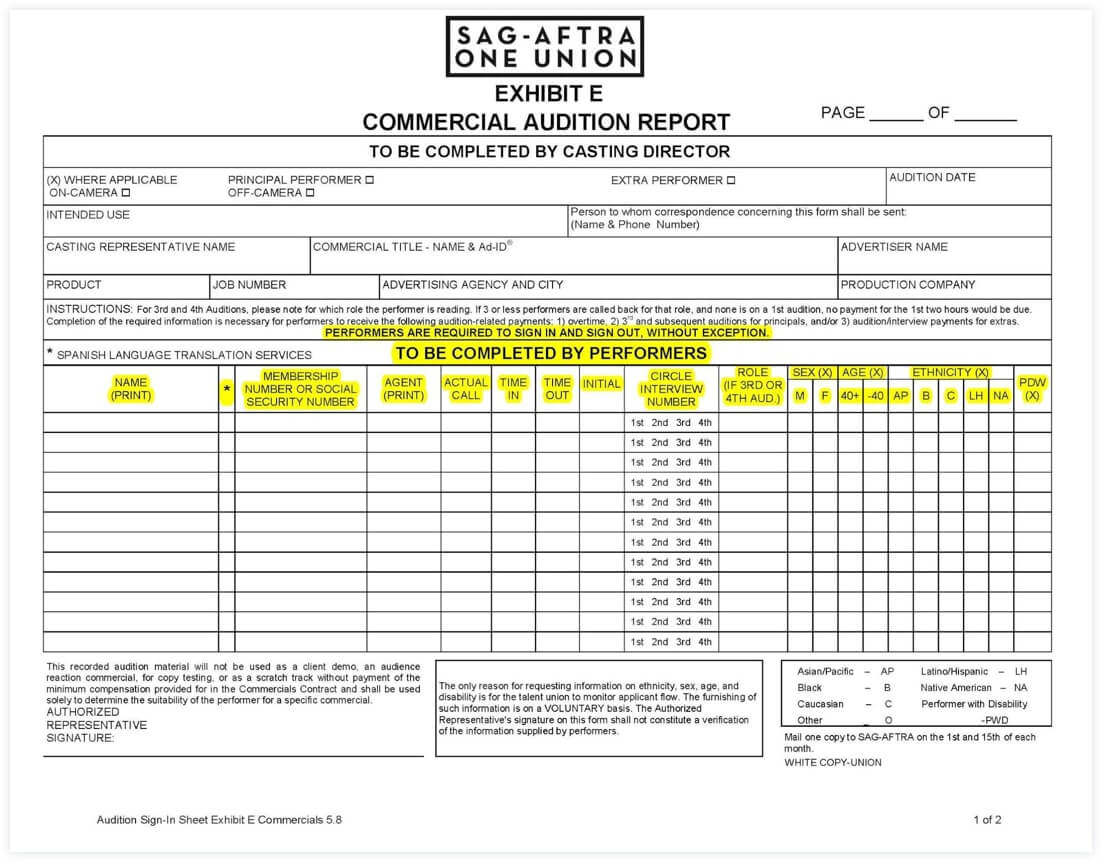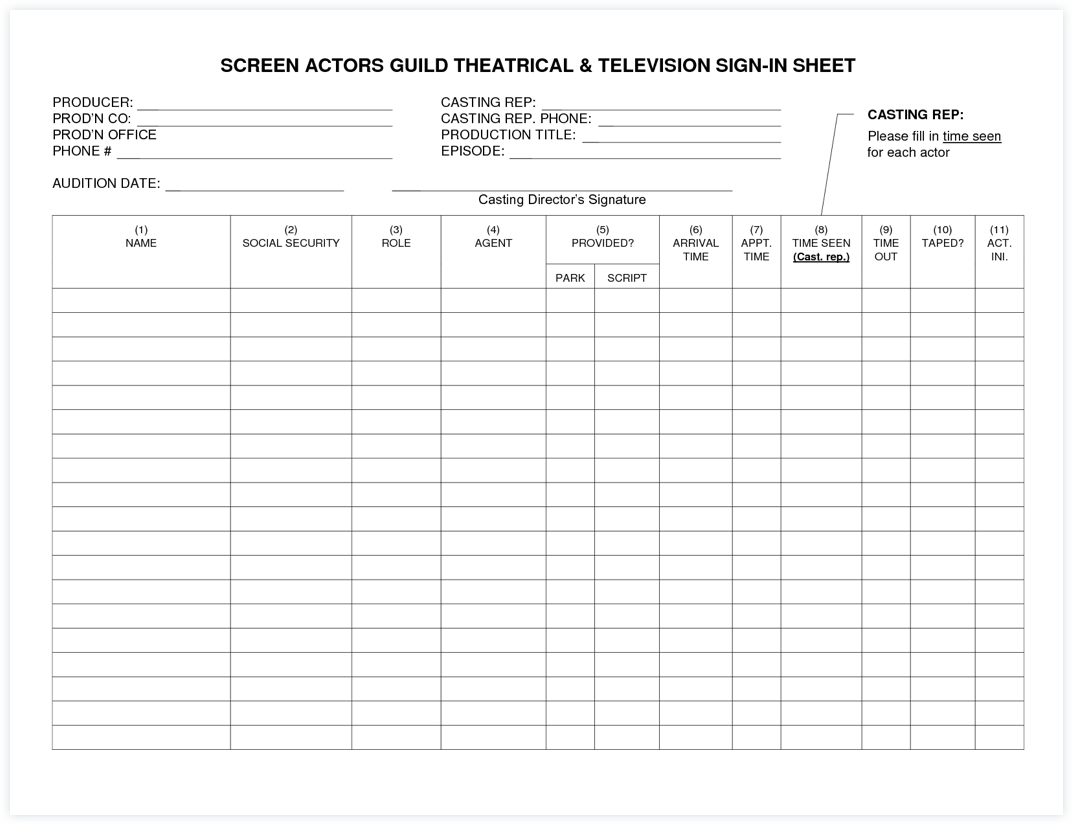Auditions. Such a simple word has so much meaning and promise. Whether running lines in the waiting room or organizing the controlled chaos that often comes, the audition process is key for casting.
One way to measure the professionalism of a production is by how well the audition goes. A chaotic audition process usually means you are in for a chaotic production. So how can you run your auditions like a pro?
Let us be your guide. We’ll cover the best way to find talent for your next project. We’ll also give you a free audition form template (a printable sign-in sheet template) that you can download and use for your casting auditions right away.
Table of Contents
Everything you need to know about holding auditions
1
The Scoop on Auditions
IT ISN’T STAR SEARCH
1.1 START WITH A SCRIPT BREAKDOWN
Create vivid character breakdowns
If you haven’t already, the first action to take leading to the all important audition is to break down your script for the roles you want to cast in your film.
Start with the biggest roles, those with the most screen time, and don’t stop until every role with speaking lines has been listed.
You definitely don’t want to leave out any characters, so carefully reading the script is very important.
Even the best eye for detail can miss something in a script.
When comes time to break down the script, we recommend using production management software. This will make sure you don’t miss any of the characters you need to include in your casting auditions.FREE DOWNLOADABLE BONUS
Download FREE Audition Form Template
This article tells you everything you need to know about holding auditions. Make sure to grab this free audition sign-in sheet template. Download it now and keep track of everyone you'll see during auditions.




1.2 CASTING BREAKDOWN
Create a casting breakdown
Use the character breakdowns you already have and build upon them to find what you’re looking for in your project. You don't just want to paint a clear picture, but you also want to entice people to submit.
They should also entice agents, managers, and producers.
Ideally your casting breakdown is very thoughtful, and any special traits or skills of the character needs to be listed in the casting breakdown.
For example, a character breakdown could read as follows:
Jane Doe (Late 30s to Mid 40s) - Audition will feature a dance test. Only submit if you have years of Salsa dance experience.
Jane is a bored housewife looking to jumpstart her life with Salsa dance lessons. She loves her husband, but feels unfulfilled in her life. She relies on her best friend to help her along the way. There is a big triumphant dance scene for the finale.
For each role you’re casting, there should be a breakdown.
Some companies, like Breakdown Services, get a bit more specific, or even read your script and create your character breakdowns for you.
Here's a video about their process:
Auditions require a great breakdown
This posting tells us everything we need to know about the character, and gets the actors thinking about the dancing requirement.
Now, depending on how and where you post your breakdowns, you will get submissions from actors who have zero Salsa dancing experience, and quite possibly a small amount of acting experience.
Use your better judgement.
Related Posts
- Related: Directing Actors for Comedy →
- Related: Start Breaking Down Your Script →
- Related: How to Analyze and Break Down a Script →
1.3 CASTING CALL NOTICE
Post your casting call notice
What is a casting call?
The casting call is the best way to let actors, agents, and managers know that you are ready to hire talent for your film.
It's an announcement that a studio, production company or independent filmmaker is seeking to hire performers for a production.
Typically, a casting call is issued in the form of a casting breakdown made to talent representatives, or to the performers themselves.
Make sure you have decided whether or not your film will be a union or non-union film. This will determine the professional level of actors you will see in your casting auditions.
Tips on casting A-list talent
As you write out your casting call notice, remember two things.
The casting notice, or casting call flyer, is the first evidence of professionalism that you’re giving to those who are not a part of your production.
The more professional and detailed the casting notice, the better your chances of getting a high level of talent, and interest from their reps.
Here is what an ideal casting notice will look like:
A WOMAN UNDONE Feature Film SAG-AFTRA Low Budget | Exec. Producers: Jack Genius, Harvey Newman and Dav Shibole Producers: Henry Riter and Emeline Rodelas Director/Writer: Eric Ingram Casting Asst: Kaydee Godfrey Audition Dates; March 25th-27th, 2019 Shoot/Start Date: Nov 15 - Dec 17, 2019 Pay Rate: SAG LB scale (except "name" submissions negotiable) Location: Los Angeles and Santa Barbara |
Remember, you will have a description for each of the characters, but they can be included in the same casting call flyer.
All of the information your talent will need should be in the casting notice.
So, again, what is a casting call? It's your announcement to the world that you're ready to cast, with all the required details included.
In the notice above, all the relevant information is there, such as:
The production name and whether it is a feature, short or new media.
UNION STATUS
The status of your project is very important. The Screen Actors Guild has several different contracts depending on the budget for your project.
Ultra Low Budget and New Media Contracts are aimed at independent producers who want the SAG designation without a huge dent in the budget or increase in talent salaries. SAG has made it easier than ever to use union talent.
How to find SAG talent to audition
But, it is a good idea to contact the Guild at least 6 weeks before you plan to audition talent in order to become signatory. You definitely want to put these dates into a production calendar so that they don’t sneak up on you.
AUDITION & SHOOT DATES
Also important: the audition dates, and shoot dates.
You don't want actors coming in to audition for a project if they won't be available to come to work. If you don't have your dates set, at least try to give them an idea of when and where the production will take place.
Pick dates for your auditions and make sure this information is set in stone before sending the casting call.
PRODUCTION TEAM INFO
If you're sending the breakdowns out to agents and managers, listing the members of the team like the producers, director and casting assistant, allows talent and reps to do background work and become excited about your work.
Next, you’ll submit to Breakdown Services or if you are more budget conscious you can submit to Backstage or LA Casting.
There are many websites to choose from when sending out a casting notice.
Don't put information on here that isn't relevant.
Don't put personal information, phone numbers, or emails.
Each company has their own specifications for posting roles. Be sure to read their directions carefully to save time and money.
Then, the headshots will start coming in volumes.
PERFORMER PAY RATE
If you're dealing with represented actors and an established producer, chances are that the pay rate for your actor will have to be negotiated a bit, and then settled upon on a standard and reasonable rate.
If you're doing some low budget filmmaking, you will want to put the rate out there as soon as possible.
The idea is to give actors the pure information as soon as possible, and even if you're not paying a thieves ransom - you'll get great submissions.
Related Posts
- Related: The Best Free Casting Websites →
- Related: Your Production Contact List →
- Related: Get a Pre-Production Checklist →
2
Preparing for Audition Day
GET READY TO BE ENTERTAINED
2.1 FIND AUDITION SPACE
Find the perfect place for auditions
Find a space to audition.
There are many empty theaters in Los Angeles. These can be ideal for casting auditions. If you choose to use a theater here is very little prep work involved.
Many theaters offer low rates to use their spaces during the day.
Peer-to-peer companies such as Wrapal or Peerspace have theater rentals as well as venues for filmmakers at reasonable rates, with locations across the US.How to hold an audition
Any office or conference room will work for the actual auditions. As long as there is good lighting, a waiting area with plenty of seating, and bathrooms.
A conference room comes off as professional, but an empty theater or gym can do the trick as well.
Whatever you do, don’t hold casting auditions in your home, or any residential area if you can help it.
Auditions from your house look unprofessional and even a bit creepy.
Talent will question the authenticity of your production if you are holding auditions at home, and wonder why they are there.
There are many casting services and spaces that offer free or reduced-fee casting, with equipment included.
One of these in LA is - Hollywood Film & Casting.
They provide cameras, a digital sign-in system, and you get a space for free.
A few things to remember ...
AUDITION TIMES
Remember to assign time in 15 to 20 minute increments to see each performer auditioning. Also, schedule a time for lunch where there is no one called. There is nothing less professional than watching someone audition while you're slurping soup or scarfing down a hoagie.
VIDEO EQUIPMENT
We highly recommend recording the auditions. Have a camera ready so you can review the best auditions over and over again.
SCRIPT SIDES
Importantly, you must have a stack of script sides in the audition space as well as in the waiting area. They should be industry standard like this:


Audition sides the old school way
Instead of going through the hassle and headache committing yourself or a coordinator to the task of pulling scenes, slicing up PDFs, and crossing out the the leftover lines, a better use of your time would be to use an all-in-one production management tool to make your audition sides.
It's the new way to create sides. Most modern productions now use this process.
Filmmakers can create custom sides in minutes. Also, distribution and confirmation of receipt is one of the features.
Here’s how it works:
Casting auditions made easy with software to create script sides
WATER
Don’t forget to have water available for yourself and for your prospective talent.
AN ASSISTANT
Also, have a reader or assistant ready to read with your talent so you can get an accurate judgment of those auditioning. If possible, you don't want to be distracted by reading with actors yourself.
AUDITION FORM TEMPLATE
The audition form template, also known as your audition sign-in sheet, logs everyone you'll see during auditions. Find more info about this crucial paperwork below. And be sure to grab your own printable sign-in sheet.
FREE DOWNLOADABLE BONUS
Download FREE Audition Form Template
This article tells you everything you need to know about holding auditions. Make sure to grab this free audition sign-in sheet template. Download it now and keep track of everyone you'll see during auditions.




2.2 MAKE A CONTACT SHEET
Organize your roster
The task of going through hundreds of headshots, whether hard copy or digital, is seemingly never ending.
But you can get through them if you practice a little organization.
Listing your talent is much more simple if you use StudioBinder’s crew list contacting features. You will be able to customize your talent list by character, potential castings, callbacks and of course audition dates and times.
Managing details of each person you call in will simplify the audition process.
How you can better manage your audition
Just remember, when you’re compiling your list you don’t have to call everyone in. In fact, it is wise to limit your selection to your top ten to twenty actors to start. Then, it’s time to call them in.
2.3 AUDITION SIGN IN SHEETS
Keep track of your talent
Next, you’ll need an audition sign-in sheet. This is non-negotiable.
Start with a good audition form template.
You will want to keep track of everyone who reads for your film.
You will also want their preferred or most recent contact information to update your own contact list.
These documents are also useful references as audition sheets for directors and producers. After you've auditioned talent, keep a completed audition form in front of you, along with the casting sheet, when discussing the actors. This way, your casting team will literally start on the same page.
There are different audition form templates, according to the union status of your project and whether it is for film, TV, or commercials and new media.
Here are two examples of the standard Screen Actors Guild commercial sign-in sheet template, called an Exhibit E.


A sign-in sheet template only for union auditions


Useful information for auditions in this printable sign-in sheet template
If you are not holding auditions for a union project, you don’t need this particular sign-in sheet for your auditions.
We would not use this for independent film, as it could send the wrong message regarding the project and the pay scale. You'll need to set parameters and be up-front with talent from the start.
2.4 CASTING SHEET
Casting sheet for your records
There is a difference between the audition sign-in sheet and a casting sheet.
The purpose of the audition sign-in sheet is to track the audition appointments. It's a scheduling tool.
The casting sheet logs detailed personal information like weight, height, eye color, etc. for your talent.
Yes, you are recording the auditions, but there are certain things the camera may not catch, and you may not remember.
Using a casting sheet is a way to keep notes as the audition progresses. You can use it to record information that is not included on the resume.
FREE DOWNLOADABLE BONUS
Download FREE Audition Form Template
This article tells you everything you need to know about holding auditions. Make sure to grab this free audition sign-in sheet template. Download it now and keep track of everyone you'll see during auditions.




You'll get a free audition form template (audition sign-in sheet) in this article. For further insight about the casting sheet, read our casting guide and grab your free casting sheet PDF.
RELATED POSTS
- Related: Complete Guide to Actor Release Forms →
- Related: How to Work with Child Actors →
- Related: Direct Like an Emmy-Winner →
3
Preparing for Audition Day
GET READY TO BE ENTERTAINED
3.1 AUDITION INTRO
Script out your introduction
The mantra for casting is short and simple…
Stay neutral.
Just be objective, dispassionate, and vague.
Whenever actors enter an audition room, it is simultaneously the most terrifying and hopeful moments of their professional lives.
Actors care about how they are perceived, so much so that they believe they can make a living out of it. They simply want their effort to be appreciated and their creative choices to be taken seriously.
Don’t abuse their passion for your project.
Casting can be enjoyable and exciting, but you need to keep your head on straight, have some tact, and be a professional.
I’ve found that the best way to go about things is to write out a script for how you introduce yourself, your team, your project, and what you’d like to see from the actor in question.
This not only gives everyone an even playing field, but it also protect you.
What directors look for in auditions | John Swanbeck
Here is an example:
“Hi Daniel Day, thanks so much for coming in today.
My name is Director and this is Casting Assistant - they will be reading with you today. As your character breakdown mentioned - Rhett is a black sheep who was expelled from West Point.
We’re excited to see what you’ve prepared - before we begin, do you have any questions, thoughts, concerns?”
This is straightforward stuff, but it is exactly the kind of thing you experience in the highest level of casting.
Resist the desire to be too chummy.
You need to keep things on-track and strike a balance between creativity, professionalism, and common human decency.
3.2 HEADSHOTS & RESUME
Headshots and resumes
Actors who have auditioned a lot will know to bring in a headshot and resume.
I’ve made it a point to ask the actors to leave their headshots and resumes at home, and to instead send hi-resolution digital copies to our casting email.
Printed photos are expensive, they are wasteful, and they do very little for the casting department because you've already invited them to audition.
Are you seriously going to use those photos in some useful way?
Will you cast one person over another based on their headshot?
Headshots and auditions | John Swanbeck
The whole point of a headshot is to see if the actor looks the part.
If you’ve invited someone to come in and audition, chances are that you saw their headshot, and thought they looked the part.
My advice - save everyone some time and money and keep digital copies.
They will be more focused on their character breakdowns and scenes rather than scrambling to print a photo and resume.
3.3 ACTORS SLATE
Actors slate into the camera
Have the actors slate their name and role into the camera.
You should have a sign-in sheet ready and they should fill out their email on that sheet, so you shouldn’t need them to provide phone numbers and emails into the camera.
Keep the momentum by sticking to the basics.
Also, I would avoid asking the actors to give you a mini-bio of their career, or give you reasons why they became an actor.
It will kill the momentum and rip them away from the character.
You don’t need to know where someone grew up, why they moved somewhere, or what they love about acting to be able to cast them.
They just need to be good and hopefully easy to direct.
3.4 DIRECTING AUDITIONS
How to analyze, comment, & direct
There is a really good way to empower actors while also keeping things on-track, and getting the best out of every audition.
Let’s go through step-by-step:
THE FIRST TAKE
On the first take, it is vital to not interrupt the actors.
Let them get through one uninterrupted performance.
Character breakdowns | Samuel L. Jackson
If you’ve done a good job with your invitations, the performances should be pretty solid, and you should have no reason to stop them. If they are having a hard time you need to be calm and allow them to finish their take.
GIVE THEM SOME DIRECTION
No matter how good or bad the take was, say this:
“That was great - let’s do it again and try it this way…”
Then, give some precise, succinct direction that is a sentence or two.
You can go deep into your story and use the audition to work through some of your own questions and concerns.
Or...
You can be a bit more loose with the tone. I’ve often found a less story driven approach is actually really helpful, both in auditions and on set.
For example:
“Let’s do it again and try it this way - right before this scene, your character was beaten up by a group of angry third graders.”
Even if this direction is ridiculous and arbitrary, it’s simple and visual.
It gives them a chance to make a big performance choice in the next take.
And, you’ve complimented their last take (regardless of the quality) and you’ve moved on and kept the momentum going.
Give them one more take, even if they didn’t do a great job.
Want a selfish reason to help you rationalize your decision?
You will have more time to consider questions and direction for the really strong actors that come in later.
THE SECOND TAKE
Do the scene at least one more time, and pay attention to how they work with the direction you’ve just given them.
Actors want parts, but they love the opportunity to take direction.
It is a big part of how they evaluate their ability and style.
Famous Actor Auditions
Some will take your direction and run with it.
Many will be too nervous and they will repeat their first take.
Others will ignore it completely and go with their instincts.
Now what?
FINAL THOUGHTS
You’ve just seen two takes of your sample scene with a particular actor, and now you have to make a decision.
Give some more direction, and run another take.
Or…
Graciously thank them for their time and move to the next actor.
Tell them they did a great job, and then decide the best course of action.
One of the great things about having a dependable casting assistant with you is that you can use them to seamlessly move on with the auditioning process in a way that keeps everything neutral.
Let’s say you’ve seen all that you need to see from an actor…
You say:
“That was great, nice work… (turn to your casting assistant) How’d you feel about that second take?”
Your assistant says:
“I liked it a lot, really bold decisions.”
Back to you:
“Absolutely... well (stand up and hold out your hand) Daniel Day, thanks for coming in, we really appreciate you taking the time to audition.”
They will smile from ear to ear, shake your hand, and leave the room.
Do NOT tell an actor whether they did, or did not get the part.
Do NOT share your thoughts on their performance.
If they ask questions about the results or about their performances, my suggestion is to stay neutral, dispassionate, and vague.
“Not sure yet. We still have a lot of self-tapes to look at and may even do call backs, but the performance had strength.”
You shouldn’t be completely sure on how you feel at this point, and you need time to see everyone and give them all a fair chance.
This isn’t about socialism or participation trophies - it’s about getting the best actors and keeping your options open.
Some will take your direction and run with it.
Many will be too nervous and they will repeat their first take.
Others will ignore it completely and go with their instincts.
Now what?
FINAL THOUGHTS
You’ve just seen two takes of your sample scene with a particular actor, and now you have to make a decision.
Give some more direction, and run another take.
Or…
Graciously thank them for their time and move to the next actor.
Tell them they did a great job, and then decide the best course of action.
One of the great things about having a dependable casting assistant with you is that you can use them to seamlessly move on with the auditioning process in a way that keeps everything neutral.
Let’s say you’ve seen all that you need to see from an actor…
You say:
“That was great, nice work… (turn to your casting assistant) How’d you feel about that second take?”
Your assistant says:
“I liked it a lot, really bold decisions.”
Back to you:
“Absolutely... well (stand up and hold out your hand) Daniel Day, thanks for coming in, we really appreciate you taking the time to audition.”
They will smile from ear to ear, shake your hand, and leave the room.
Do NOT tell an actor whether they did, or did not get the part.
Do NOT share your thoughts on their performance.
If they ask questions about the results or about their performances, my suggestion is to stay neutral, dispassionate, and vague.
“Not sure yet. We still have a lot of self-tapes to look at and may even do call backs, but the performance had strength.”
You shouldn’t be completely sure on how you feel at this point, and you need time to see everyone and give them all a fair chance.
This isn’t about socialism or participation trophies - it’s about getting the best actors and keeping your options open.
3.4 FINAL CASTING STEP
Final step once you’re all done
So, you just made it completely through your audition.
You were calm, professional, and you got the most out of your actors.
Now, you have to decide on who to cast, and how you will go about letting the actors know that they got the part.
My suggestion is to send personal emails to each.
Tell them why you chose them, what they did well in the audition, and what you’re excited about going forward.
Remind them of the shoots dates and any other important information.
Think of it like an acceptance letter from a university; say congrats, give them important orientation information, and thank them for auditioning.
There are few things more exciting than an actor booking a part, so give them a memorable experience that is pleasant and professional.
If your production is smaller than they’re used to, this will go a long way.
UP NEXT
Casting Tips for Filmmakers
Holding auditions is only part of the work you’ll do to find talent for your project. Make sure you know all the insider’s tips on casting. You'll need to choose your cast wisely, be realistic, and remember to make room to surprise yourself.
Find out what the pros already know about casting, from the basics on up to advanced pointers. Your cast can make or break your film. So cast it right!
